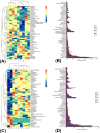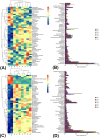The synergistic interaction effect between biochar and plant growth-promoting rhizobacteria on beneficial microbial communities in soil
- PMID: 39748822
- PMCID: PMC11693716
- DOI: 10.3389/fpls.2024.1501400
The synergistic interaction effect between biochar and plant growth-promoting rhizobacteria on beneficial microbial communities in soil
Abstract
Excessive use of chemical fertilizers and extensive farming can degrade soil properties so that leading to decline in crop yields. Combining plant growth-promoting rhizobacteria (PGPR) with biochar (BC) may be an alternative way to mitigate this situation. However, the proportion of PGPR and BC at which crop yield can be improved, as well as the improvement effect extent on different eco-geographic region and crops, remain unclear. This research used cabbage [Brassica pekinensis (Lour.) Rupr.] as the target crop and established as treatment conventional fertilization as a control and a 50% reduction in nitrogen fertilizer at the Yunnan-Guizhou Plateau of China, adding BC or PGPR to evaluate the effects of different treatments on cabbage yield and the soil physicochemical properties. Specifically, high-throughput sequencing probed beneficial soil microbial communities and investigated the impact of BC and PGPR on cabbage yield and soil properties. The results revealed that the soil alkaline hydrolyzable nitrogen (AH-N), available phosphorus (AP), and available potassium (AK) contents were higher in the BC application than in control. The BC application or mixed with PGPR significantly increased the soil organic matter (OM) content (P<0.05), with a maximum of 42.59 g/kg. Further, applying BC or PGPR significantly increased the abundance of beneficial soil microorganisms in the whole growth period of cabbage (P<0.05), such as Streptomyces, Lysobacter, and Bacillus. Meanwhile, the co-application of BC and PGPR increased the abundance of Pseudomonas, and also significantly enhanced the Shannon index and Simpson index of bacterial community (P<0.05). Combined or not with PGPR, the BC application significantly enhanced cabbage yield (P<0.05), with the highest yield reached 1.41 fold of the control. Our research indicated that BC is an suitable and promising carrier of PGPR for soil improvement, combining BC and PGPR can effectively ameliorate the diversity of bacterial community even in acid red soil rhizosphere, and the most direct reflection is to improve soil fertility and cabbage yield.
Keywords: beneficial microbial communities; biological agents; rhizosphere microorganisms; soil improvement; soil physicochemical properties.
Copyright © 2024 Zou, Zhao, Guan, Chen, Zhao, Zhao, Du and Xie.
Conflict of interest statement
The authors declare that the research was conducted in the absence of any commercial or financial relationships that could be construed as a potential conflict of interest.
Figures





Similar articles
-
[Differences in Soil Fertility and Bacterial Community Structure Between Carbon Inputs such as Biochar and Organic Fertilizer and Their Relationship].Huan Jing Ke Xue. 2024 Jul 8;45(7):4218-4227. doi: 10.13227/j.hjkx.202307062. Huan Jing Ke Xue. 2024. PMID: 39022968 Chinese.
-
[Effects of Different Fertilization Treatments on Bacterial Community and Citrus Quality in Yellow Soils of the Yunnan-Guizhou Plateau].Huan Jing Ke Xue. 2024 Dec 8;45(12):7337-7349. doi: 10.13227/j.hjkx.202401001. Huan Jing Ke Xue. 2024. PMID: 39628197 Chinese.
-
Broad-spectrum applications of plant growth-promoting rhizobacteria (PGPR) across diverse crops and intricate planting systems.Microbiol Spectr. 2025 Mar 4;13(3):e0187924. doi: 10.1128/spectrum.01879-24. Epub 2025 Jan 22. Microbiol Spectr. 2025. PMID: 39840969 Free PMC article.
-
Biotechnological advances in plant growth-promoting rhizobacteria for sustainable agriculture.World J Microbiol Biotechnol. 2024 Dec 30;41(1):21. doi: 10.1007/s11274-024-04231-4. World J Microbiol Biotechnol. 2024. PMID: 39738995 Review.
-
Insight into soil nitrogen and phosphorus availability and agricultural sustainability by plant growth-promoting rhizobacteria.Environ Sci Pollut Res Int. 2022 Jun;29(30):45089-45106. doi: 10.1007/s11356-022-20399-4. Epub 2022 Apr 26. Environ Sci Pollut Res Int. 2022. PMID: 35474421 Review.
Cited by
-
Comprehensive quantitative evaluation and mechanism analysis of influencing factors on yield and quality of cultivated Gastrodia elata Blume.Sci Rep. 2025 May 27;15(1):18457. doi: 10.1038/s41598-025-99706-1. Sci Rep. 2025. PMID: 40425731 Free PMC article.
References
-
- Alam T., Bibi F., Fatima H., Munir F., Gul A., Haider G., et al. . (2024). Biochar and PGPR: A winning combination for peanut growth and nodulation under dry spell. J. Soil Sci. Plant Nutr. 2024. doi: 10.1007/s42729-024-02067-3 - DOI
LinkOut - more resources
Full Text Sources

